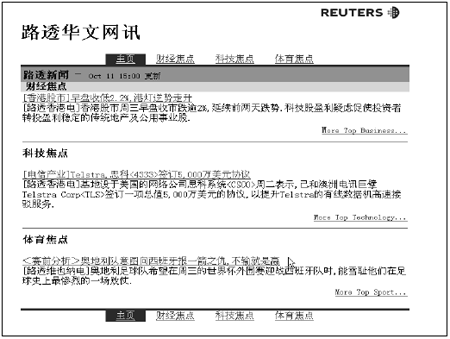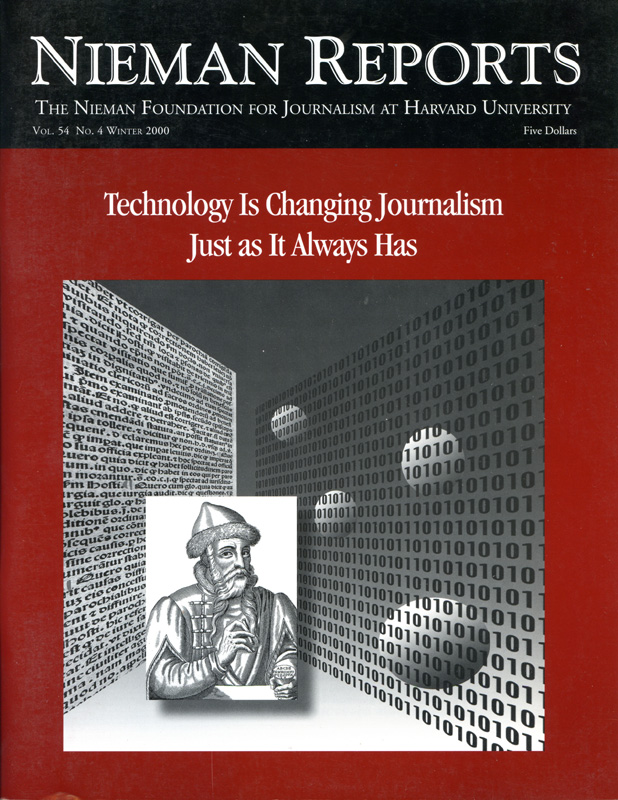
A screen grab showing the demo home page of the Reuters’ Chinese Online Report, a real-time multimedia publication edited and filed by a team of Reuters journalists in Taiwan.
Last spring, Reuters’ top war correspondent Kurt Schork was killed in a rebel ambush in Sierra Leone. Reuters Editor in Chief Geert Linnebank, in his eulogy honoring Schork, said the pragmatic reporter might have assumed that because he wrote for a “wire,” his byline did not reach the public at large.
“Kurt Schork was Reuters’ finest war reporter. He shed a lot of light on a lot of awful places. He wanted to, and often did, help bring about change. Actions were hastily reversed, official policies changed, public opinion mobilized under the sustained battering of Kurt’s incontrovertible reports,” Linnebank said. “Kurt, the pragmatist, knew that if his byline did not gain fame with a broad public audience, it really did register with those of influence and power.”
But Schork’s reports from these war zones did reach an incredibly wide audience because of the Internet. The month Schork died, 34 million people saw Reuters’ news stories online around the world, according to Reuters Media Research estimates based on government reports and professional online data collection companies. By fall 2000, that number had grown to 50 million people each month.
At its most basic, that is the revolution the Web has wrought for the wires. It is about access, with little or no filtering, for a vast number of end users, general-public news consumers. From relative obscurity outside of newspaper copy desks and financial trading rooms, wires like Reuters, Dow Jones, The Associated Press (AP), United Press International (UPI), France’s Agence France-Presse (AFP), Germany’s Deutsche Presse-Agentur (DPA), and others have become household names as the work of extraordinary wire journalists like Schork becomes widely available for public consumption.
The Internet has pumped lots of positive change into the world of journalism and the wires. I can only speak for the revolution at Reuters, a 150-year-old international news and financial information company, whose British roots anchor its commitment to accuracy, freedom from bias, global breadth, and speed. (Our Web address is www.reuters.com.)
In the early 1990’s, as the Web was putting forward its public face with the launch of user-friendly browsers, some forward-thinkers at Reuters noticed the strong synergy between the Internet, described as a global network of networks, and Reuters, which is a global network of news production. Common characteristics included the ability to make news available in real time, 24/7; the ability to be at once global and local; the ability to present news in a nonlinear fashion, and the ability to showcase multimedia, multicultural and multilingual content. And they noticed that, with the glut of unreliable information out there, reliability was a premium.
At Reuters we call this sea change the “News” Millennium. It means that technological change is challenging our old perceptions of how news is delivered and consumed. The Internet is a medium without limitations. Newspapers and magazines publish only daily, weekly or monthly. Television and radio have time limitations and have no choice but to present their news in an unchangeable linear order. But the Internet provides real-time, multimedia news around the clock with no technological limits on story length and nearly unlimited access to related content of interest to the news user. The technology allows the user to create a unique news experience that is personal, interactive, nonlinear and multimedia capable.
To complicate matters, online news consumers want it both ways. They need experienced newsgatherers and publishers to help them sort through the information overload on the Web. But in a multi-channel universe, they also want to be their own publishers, taking part in deciding what news is most relevant. So the question for news organizations like ours is how to create high quality, appealing multimedia news publications for online clients and end users.
At Reuters, one answer has been our multimedia Online Reports product suite. It features packages of news, segmented into channels. Typical channels would resemble sections of traditional publications: top news (the front page), business, entertainment, sports, science, health, technology, etc. Each category lists stories by priority with XML (Extensible Markup Language) tags. These tags indicate what is the number one story and continue through number 10. Pictures, news graphics, and video clips are tagged as well to indicate which stories they are associated with. These publications feature careful editorial selection and prioritization of content by experienced Reuters journalists around the world. The format can be adapted to any language and any combination of content. From just a handful of Online Reports desks 18 months ago, we now have 22 of them publishing multimedia news in 11 languages across 18 countries.
What has been especially exciting for journalists at Reuters with the development of these new publications for the Internet, is that each desk has a group of specially trained multimedia journalists/producers who “own” their publication. They become “local” publishers, whose online publications sell worldwide. Our Arabic-language Online Report, for example, is selling well in the Middle East and in the United States. These Online Reports teams are empowered to continually work to improve their publications and respond to clients and readers.
Typically, the online clients will request additional topics of multimedia news presentation, based on their own readers’ feedback. One client might want more about technology or Internet news. Another might ask for specialized “top picture” displays or specific favorite sports news publications, which vary dramatically from country to country. The Online Reports’ journalists also act as a global team, sharing information about the packaging process and “best practices” for multimedia development and filing.
Reuters employs more than 2,300 correspondents in more than 160 countries. Each day they produce between two and two and a half million words—the equivalent of three copies of the Bible—in 24 languages. Hundreds, sometimes thousands of pictures and hours of video accompany that text output. Before the Internet, Reuters delivered this vast stream of content down wide pipes to wire editors at client sites. A limited amount of this content found its way into newspapers, magazines or TV or radio broadcasts.
Now, the Internet has forced us to reinvent how we package our news content and present it for online publishers and their end users. Client publishers can be anyone who has an online site. From the smallest new dot-com to the largest portal, these publishers understand how important it is to provide quality breaking news on their sites to attract and keep the end user, the news consumer. But few of them can afford news staff to publish 24/7. In fact, many of our traditional clients are now also taking advantage of our new real-time multimedia products for their online sites in addition to subscribing to the wire service products.
One of our critical challenges to continued success in global news publishing is adapting to the continually changing technologies. Internet publishers require Internet delivery, so Reuters added that option to its delivery suite in early 2000. The Reuters Internet Delivery System offers clients multimedia products with content tagged in XML but we are also now testing NewsML, a news encoding language based on the established XML format.
The U.K.-based International Press Telecommunications Committee, a news industry standards body, approved NewsML in October. One of its key features is that it uses “metadata”—information about a story such as its author, subject, content, coding, etc.—to match up elements for a multimedia package and also to categorize text, photos, video and graphics for historical databases. Metadata is invisible to users but it is essential for enabling clients to search for our news quickly and easily in a Web environment.
Segmentation and NewsML will allow us to adapt our Online Reports’ news stories to the new information delivery mechanisms, including mobile telephones and other hand-held wireless devices that are burgeoning, especially in Europe. We are actively developing products that address these client needs across platforms, including audio for voice portals, video on demand, and live streaming video.
All of this innovation is still based on the basics, which means solid reporting, writing and editing and quality news picture and video coverage. The revolution lies in thinking about how the technology makes it possible for the important work of fine “wire” journalists to reach as many end users in as many ways as possible.
Katie King, a 1994 Nieman Fellow, is vice president, general news at Reuters Media. She has worked with Reuters for 15 years as a foreign correspondent, multimedia editor, and Internet news specialist. She joined Reuters NewMedia, Reuters’ founding Internet news development division, in 1994 and launched the company’s first daily multimedia news publication later that year. Since January 1999 she has been coordinating Reuters’ global multimedia product strategy and development.



